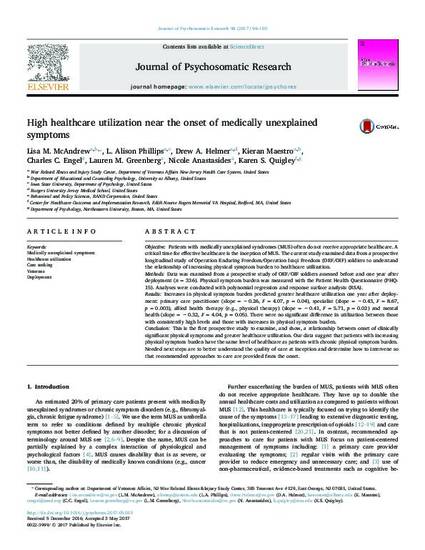
Objective: Patients with medically unexplained syndromes (MUS) often do not receive appropriate healthcare. A critical time for effective healthcare is the inception of MUS. The current study examined data from a prospective longitudinal study of Operation Enduring Freedom/Operation Iraqi Freedom (OEF/OIF) soldiers to understand the relationship of increasing physical symptom burden to healthcare utilization.
Methods: Data was examined from a prospective study of OEF/OIF soldiers assessed before and one year after deployment (n = 336). Physical symptom burden was measured with the Patient Health Questionnaire (PHQ-15). Analyses were conducted with polynomial regression and response surface analysis (RSA).
Results: Increases in physical symptom burden predicted greater healthcare utilization one year after deployment: primary care practitioner (slope = − 0.26, F = 4.07, p = 0.04), specialist (slope = − 0.43, F = 8.67, p = 0.003), allied health therapy (e.g., physical therapy) (slope = − 0.41, F = 5.71, p = 0.02) and mental health (slope = − 0.32, F = 4.04, p = 0.05). There were no significant difference in utilization between those with consistently high levels and those with increases in physical symptom burden.
Conclusion: This is the first prospective study to examine, and show, a relationship between onset of clinically significant physical symptoms and greater healthcare utilization. Our data suggest that patients with increasing physical symptom burden have the same level of healthcare as patients with chronic physical symptom burden. Needed next steps are to better understand the quality of care at inception and determine how to intervene so that recommended approaches to care are provided from the onset.
Available at: http://works.bepress.com/lalison-phillips/30/

This article is published as McAndrew, Lisa M., L. Alison Phillips, Drew A. Helmer, Kieran Maestro, Charles C. Engel, Lauren M. Greenberg, Nicole Anastasides, and Karen S. Quigley. "High healthcare utilization near the onset of medically unexplained symptoms." Journal of Psychosomatic Research 98 (2017): 98-105. DOI: 10.1016/j.jpsychores.2017.05.001.